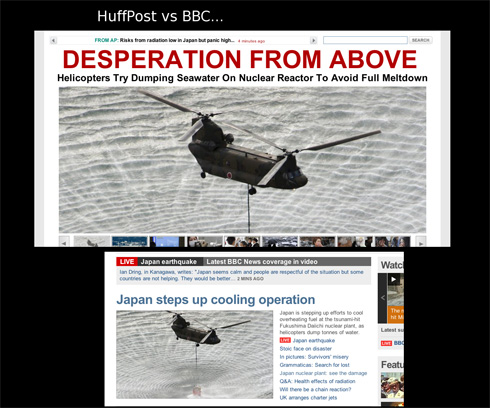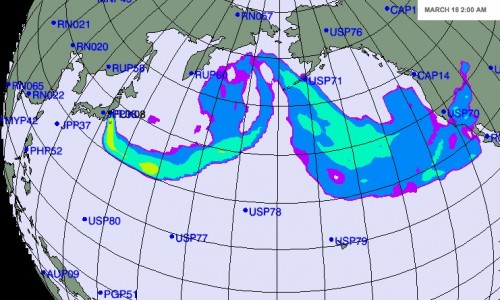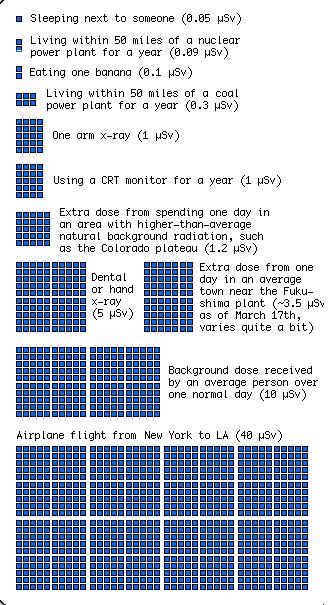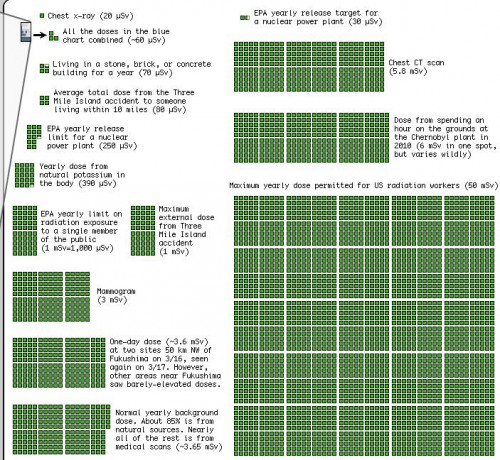When the earthquake and tsunami hit Japan, the twin disasters received a lot of media attention. However, it didn’t take long before concerns about the situation at the Fukushima Daiichi nuclear reactors became a major focal point of media coverage. I remember first hearing about the explosion that damaged the outer containment building at one of the reactors. Every few hours brought more news accounts that seemed to indicate impending disaster — possible radiation clouds set to arrive in Tokyo within hours, evacuations of employees from the reactors, more explosions, the possibility that a full core meltdown would occur. Officials in the U.S. expressed concern about the 20-kilometer (12 1/2-mile) evacuation zone established by the Japanese government and suggested Americans evacuate a larger area.
But criticisms have emerged of media — particularly much of the non-Japanese media — coverage of the problems at the nuclear reactor, suggesting the reporting was often inaccurate or that the severity of the situation and potential dangers were exaggerated, and as a result drew attention away from the destruction and suffering caused by the earthquake and tsunami. The blog Japan Probe posted screen captures illustrating the different tone of coverage of the attempt to dump water from military helicopters onto Reactor 3 as part of the efforts to keep the fuel rods cool. The first, from the Huffington Post, implies more of a sense of panic and looming disaster than does the title to a BBC article using the same photo:
Japan Probe also links to a New York Times map, titled “Forecast for Plume’s Path Is a Function of Wind and Weather,” that shows when various detecting stations could potentially be able to pick up what the NYT takes pains to say would be “extremely low levels” of radiation that would have “extremely minor health consequences” (that last phrase bolded). Here’s the scenario that was forecast for March 18:
Scary, right? But then take a look at the color legend for the map:
The radiation levels indicated by different colors are reported in “arbitrary units.” So the different colors reflect differences in the potential level of radiation as it might hypothetically spread. But it’s based on a scale where the reader has no way to know whether the difference between purple, yellow, and red are actually meaningful and whether everything from 0.001 to 100 units, or a hundred billion gazillion units, all still count as “extremely low levels”of radiation, or if the red would indicate we’re all going to die.
I’m sure that the scientists who developed the model explained what the arbitrary unit was, but as provided in the NYT map, despite the text saying there is little to fear in terms of health, the map with the color coding seems likely to generate concern without providing much useful information.
UPDATE: Dmitriy T.M. just emailed me a link to a post about this topic at TechCrunch, which includes a clip from CNN in which Nancy Grace “schools” a meteorologist about how he’s totally wrong about radiation:
And the San Francisco Chronicle has a post up on SFGate summarizing some of the problems with coverage (via Talking Points Memo).
On the topic of concerns about radiation levels, my friend Kelly V. sent me a graphic put together by xkcd to put the level of radiation exposure from various sources into some context. The image is too large to fit in the space available here, but it’s worth clicking over to take a look. Here are two segments of it, but really, go look at the full image:
I’m certainly not in a position to adequately sort through the actual dangers posed by what’s going on at the Fukushima reactors, but it’s certainly worth questioning media coverage, especially insofar as that coverage drew attention away from the horrendous aftereffects of the earthquake and tsunami.
On a related note, and as a contrasting example, Dmitriy T.M. sent in a cartoon based on an idea by artist Kazuko Hachiya that explains the problem at the Fukushima Daiichi facility to kids through metaphors about constipation, pooping, and farting. So…there’s that. It’s unclear whether the video has really been shown on Japanese TV to actual children or not.
UPDATE: Reader Rei Tokyo, who lives in Tokyo, says the video has never been shown on local TV to their knowledge. I have a feeling this is more of an internet sensation outside Japan than within it.






Comments 29
Jason Patch — March 24, 2011
Deny, Deflect, Defend. That's what Klinenberg identified in his book "Heat Wave" about how politicians treat disasters. I think the shift to "foreign media" is part of the deflect mode. Everything is under control, but the foreign media is causing hysteria! Now that the head of water purification for the Tokyo water department has reported iodine 131 at 2x recommended levels for infants these acts of denial and deflection look particularly bad (maybe this news is only in the NY Times). The above cartoon animation which has been making the rounds (Facebook, Twitter, etc.) doesn't seem as cute when water is undrinkable. If anything the readings of the images above could be reversed: the Japanese use overly bland titles or childlike techniques to obscure.
Jeremy — March 24, 2011
"It’s unclear whether the video has really been shown on Japanese TV to actual children or not."
I'll ask around if anyone's seen it.
It's been crazy seeing the reactions coming in from people within Japan and from friends & family back home. I live 300km southwest of the plant and have never been in any danger whatsoever, but I've had family calling offering to fly me out, asking if I'm ready to evacuate, etc. Inside Japan, most people have been totally calm about it, the public schools I teach in have been going about the business as usual, everyone, businesses included have been working around the scheduled blackouts, and last weekend Yoyogi Park in Tokyo was crowded with people relieved to have good weather on a weekend and determined to enjoy themselves despite the fear-mongering.
Marc — March 24, 2011
I think media companies have a hard time hiring and keeping people who are both numerate and good writers. Those sorts of people have ample opportunities for highly remunerative employment elsewhere in non-dying industries.
On top of that, if it bleeds, it leads. The two combine predictably to lead to news organizations not exactly covering themselves in glory when these types of stories come up. HuffPo is an organization that uses a lot of T&A to drive traffic, so you should expect a more hysterical tone from them.
As to the NYT, You saw the same type of gushy data handling during the gulf oil spill. If these people were better at labeling graphs, they'd work somewhere else.
As to the first commenter, you sound like you have an attitude of permanent suspicion towards establishment. How do you feel about vaccines?
I love the XKCD graphic. I think people would be better able to comprehend low-level radiation risks if they were communicated in units of Glowing Bananas.
For Japanese children, a cartoon to explain the nuclear problem | Sovereign Nations — March 24, 2011
[...] via Sociological Images [...]
d — March 24, 2011
Is the NYT graphic the one that MIT NSE was referring to as being totally bogus? See the last paragraph at http://mitnse.com/2011/03/17/on-worst-case-scenarios/
A — March 24, 2011
I'm in a cafe and CNN is on the screen right now with the developing story "Radiation in the Wind." Now some guy is explaining that really, there have been no spikes in radiation in most U.S. cities after the earthquake. So why was "Radiation in the Wind" the title rather than "No Radiation in the Wind"?
So yeah, I've been seeing a lot of misleading language about the risks of nuclear radiation from this plant. And seriously, why aren't these news websites doing a better job of putting the "radiation" from the plant into perspective, comparing it to radiation from X-rays or even certain types of bedrock (Grand Central commute, anyone?). I love that XKCD did it, but is CNN or FoxNews doing something similar?
It seems like a pity because this would be a great opportunity to educate people about nuclear power and about the actual radiation risks. Instead it's about fearmongering.
Bob — March 24, 2011
The color scale on the NYT map is also misleading. 0.001 units is hard to distinguish from 100 units. A quick glance shows purple everywhere, and the hues for the high and low are similar. Its only my recognizing the adjacent colors are also low that you realize the maximum contour on that graph is only 1 au.
Marc — March 24, 2011
It's really easy to see the laziness / perfidity of the news media when they're reporting on something technical where it's simple to check on them.
It's tougher when they report numbers related to social sciences, or other things that aren't as cut and dried, or available from alternate sources.
Toughest of all is catching bad reporting and laziness when the conclusion of the reportage backs up something you already think is so.
martian creole — March 24, 2011
The American media and government also went off the deep end about the Toyota recalls. Many car companies (and other companies) recall products all the time, but Toyota is singled out. There's probably a widespread fear of Japan (perhaps as a proxy for China?) behind this.
decius — March 24, 2011
"I know that radiation comes across the ocean, it is dissipated by wind current and salt spray, but it is reaching the shore of California."
I see four factual errors in that one sentence: Radiation is only line-of-sight, so for radiation to travel from Japan to California is through the ocean, not over or across it; radiation is not affected by wind currents in any way; nor by salt spray; nor is radiation (in any significant sense of the word) traveling from Japan to California.
If she meant contamination, she should have said so. The activity of any particulate contamination present in air is simple to measure, but requires being physically present long enough to get a sample. That's not a radiation hazard, it's a physical difficulty when discussion plumes in the mid to upper atmosphere.
"Radiation not just in the air, but in the food, water, livestock, produce, supplies..."
Considering that list as one item, it's only one gross conceptual error. Radiation is not 'in' things in the way that heat is in things, but in the way that light is 'in' things. Food that has had a flashlight shone on it (irradiated) does not glow (is not radioactive). Food that has glow-in-the-dark paint spilled on it (contaminated) does glow (is radioactive). But the paint (contamination) can be removed, and it is simple to measure the amount of paint (contamination), by using a photometer (radiac).
Admittedly, some crops present problems with the above mentioned method of determining how much accident-related contamination is present: Tobacco, for example, is naturally detectably radioactive, and people who smoke or have tobacco products on their person are measurably more radioactive than people who perform chemistry on the coolant of nuclear power plants.
Quercki — March 24, 2011
I checked to see if the governor of California had issued a state of emergency for radiation. No. Just for the towns hit by the tsunami. Like the weather person said.
http://californianewswire.com/2011/03/17/CNW8649_173023.php
Village Idiot — March 24, 2011
That Nancy Grace clip is just more evidence that we're sliding into Dark Age v2.0. Or it might be more accurate to call this "The Lite Ages," which seems to capture its bright shiny vacuity better (I forget which movie that title came from, but it's perfect). Jon Stewart turned that Nancy Grace clip into comedy gold, btw.
In related news, it appears that the entire network is as ignorant and/or barely literate as Nancy. Check out the headlines at the bottom of the screen: "American teacher found dead in Japan after family told she alive." Why they tell she alive if she no alive? That not good, bad news! Bad!!
But wait, there's more...
"Food safety situation is 'more serious' b/c levels of radiation are being detected farther away than thought."
Uh, "b/c?" Really? Is the news being issued in text messages now, even on TV? WTF? (lol)
"...farther away than thought?" Hardly, if they had any idea how far away some people's thoughts can get (especially mine!), they wouldn't make such a ridiculous claim.
And saving the best for last, the oh-so-helpful "...levels of radiation are being detected..." OMG! Run for your life b/c LEVELS are being DETECTED! Do you know what this means?!? It means you should be scared! Are you? Boo! Ok, how about now? I already bought those special io-whatever pills so my hair doesn't fall out and I won't turn into a zombie and stuff from eating the glow in the dark spinach but I'm also a little hesitant because it might be my only chance to maybe get super powers so part of me doesn't want to take the pills... Oh I don't know, it's all so confusing and scary so I think I'll turn on the news b/c I'm sure it'll put me at ease with calmly-explained facts and reasonable analysis.
Seriously though, being as familiar with mainstream media as I am, the BBC headline "Japan Steps up Cooling Operation" scared the hell out of me when I first saw it, but then I relaxed when I saw the hysterical Huffington Post version. If the shit is truly hitting the fan I expect bland, understated headlines, like "Playful Asteroid To Give Earth Peck on Cheek This Friday" or something like that, and I think the BBC headline qualifies as such. When I see a headline like "Doomsday Arrives! You're Gonna Die!" I relax b/c I know it's just a slow news day.
Rei Tokyo — March 24, 2011
I live in Tokyo. Such a video doesn't flow on TV. It saw for the first time now.
[links] Link salad is lonely out in space | jlake.com — March 25, 2011
[...] Media Coverage of the Fukishima Nuclear Reactor Crisis [...]
Links that Will Change Your World! | Ted Paulson -- Sociology blog — March 26, 2011
[...] The Society Pages Fantastic look at how our viewpoint affects perception. [...]
Links That Will Change Your World! | Ted Paulson -- Sociology blog — April 2, 2011
[...] A fantastic look at the role media plays in the Japan nuclear reactor disasters caused by the earthquake. Sociological Images. [...]